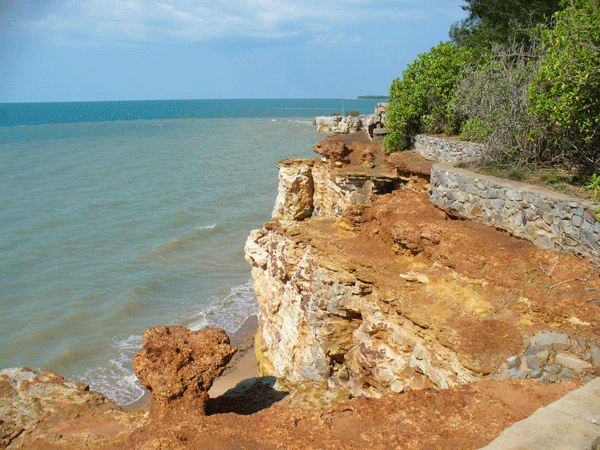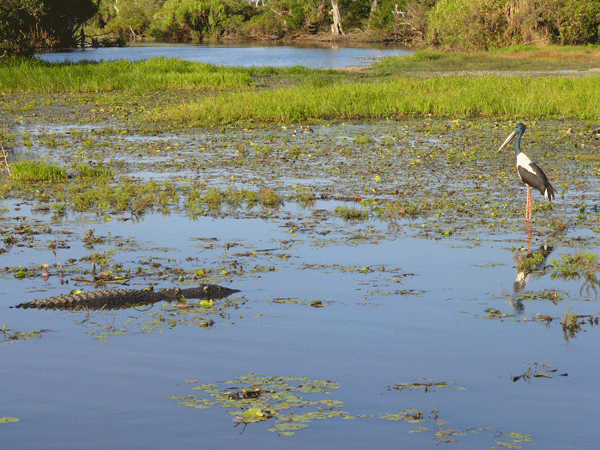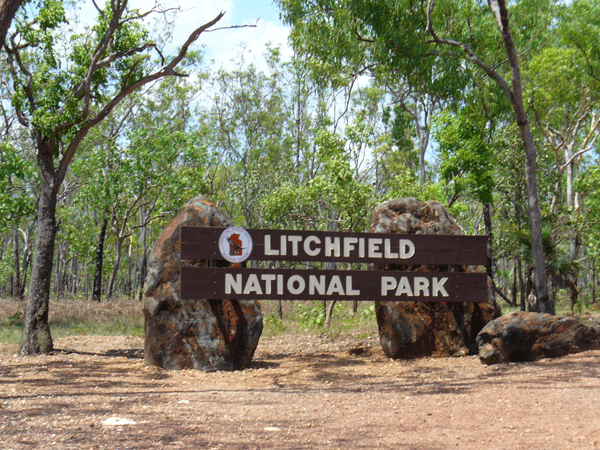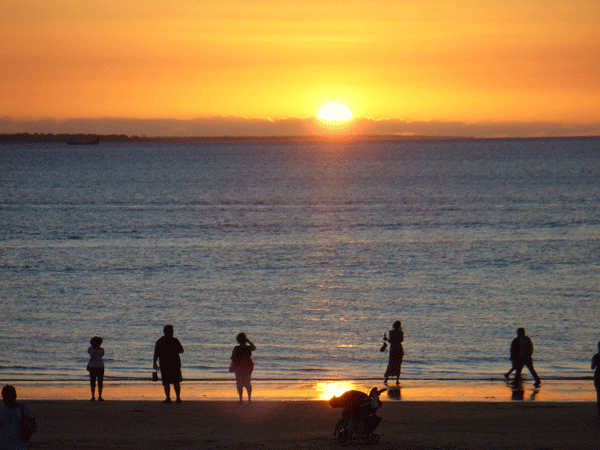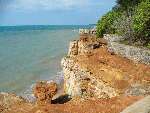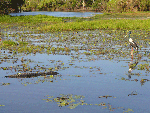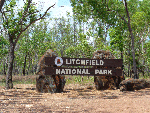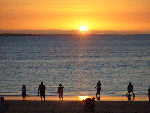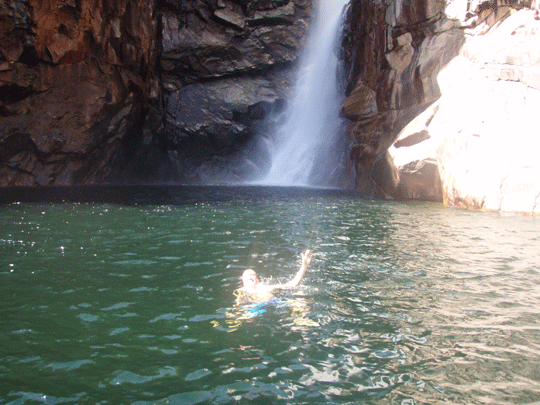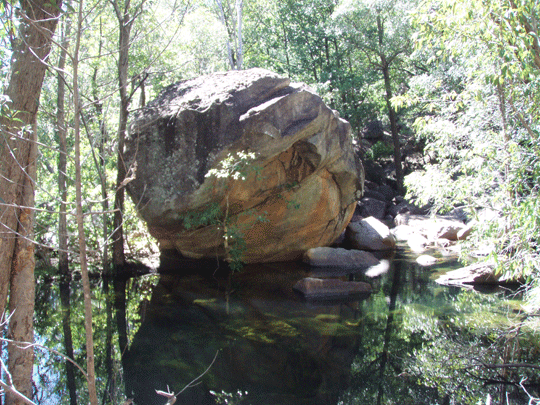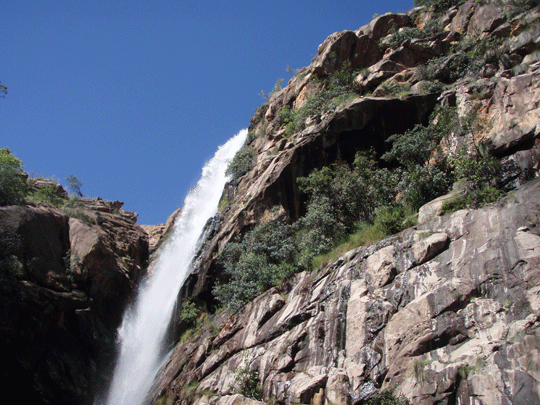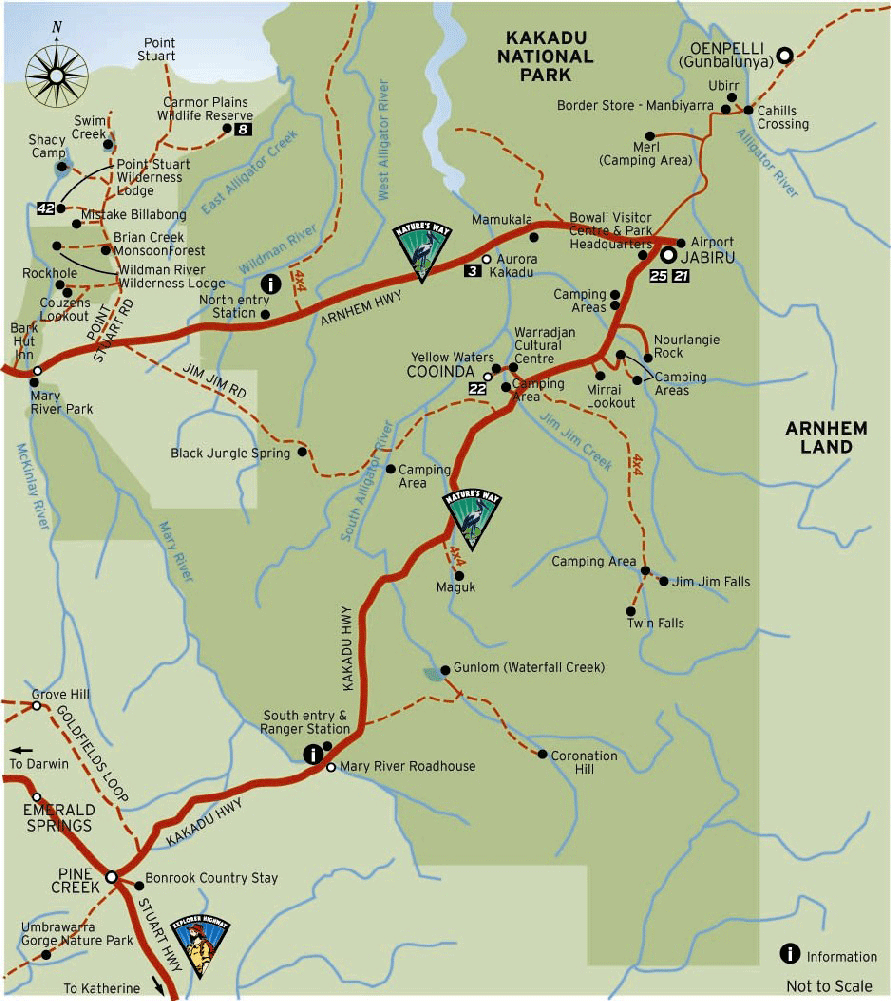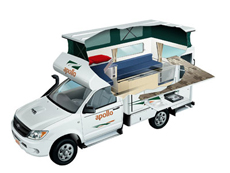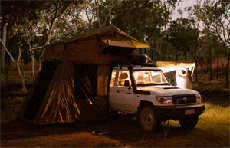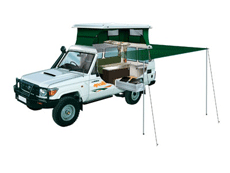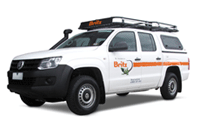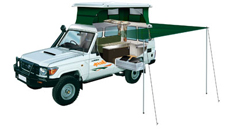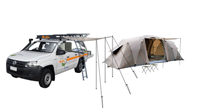About Motorcar Falls (Motorcar Creek Walk),
Moline Rockhole, Kurundie Falls and Boulder Creek
in Kakadu Australia
Where Is Motorcar Creek Walk
Distance: 11 km return
Time: 7 hours, long day walk
Grade: difficult, unmarked track
Carry a topographic map and compass, or a GPS. Camping permit
required. This walk follows the Motor Car Falls walk to Motor
Car Falls. Then an unmarked section follows Motor Car Creek downstream
to a series of lower falls. The adventurous may continue along
the creek to the South Alligator River. Estuarine (saltwater)
crocodiles live in the river so do not swim there. Return the
way you came. This walk is most enjoyable in the wet season. Motorcar
Falls can be reached via the Yirrmikmik Walk. The walk takes you
through woodlands peppered with termite mounds and is approximately
7.5 km. Motor car falls was named in 1946 when the first vehicle
to drive into the area, reached the creek and could not pass through.
A bridge has since been built.
Where Is Moline Rockhole
Moline Rockhole is a little known, but beautiful, small waterfall
and rockhole just several kilometres from Goymarr Tourist Park
. Goymarr Tourist Park is in the process of developing a walking
track between the Tourist Park and Moline. It is not signposted
so you will need to ask directions at the Visitor Information
Centre. Moline offers safe swimming for much of the year but you
must first check Visitor Information Centre that's our advice.
Where Is Kurundie Falls
Motor Car and Kurrundie Creek Circuit
Walk Distance: 14 km return
Time: 10 hours, overnight walk
Grade: difficult, unmarked track
Kurundie Falls is located approximately 2km from Motor Car falls
and is also accessable along the Yirrmikmik Walk. Kurundie often
attracts less visitors as many people do not take the time to
walk the extra distance. Carry a topographic map and compass,
or a GPS. Camping permit required. Follow the old vehicle track
past Yurmikmik Lookout to Kurrundie Creek, then follow the creek
upstream to Kurrundie Falls. At this spectacular place you may
see ngalmirla-mirla (peregrine falcon) flying from the cliffs.
Also keep an eye out for barrk (black wallaroo) amongst the rocks.
Follow the creek downstream through more falls to the South Alligator
River. Estuarine (saltwater) crocodiles live in the river so do
not swim there. Return to the carpark by following Motor Car Creek
to the old bridge and vehicle track.
Where Is Boulder Creek
Boulder Creek
Walk Distance: 2 km loop
Time: 45 minutes
Grade: moderate, marked track
Plum Tree Creek near the start of this walk is just a sandy creek
bed during the dry season. It is named after mindu, the billygoat
plum. Birn-birndok (striated pardalotes) and wirrirtwirrirt (rainbow
bee-eaters) nest in the banks of this creek. After passing through
open woodland the track leads to Boulder Creek, which is lined
with a monsoon forest. Amongst the boulders are Garnbayn (fan
palms). Listen and look for birds, like bukbuk (pheasant coucal).
Feel the texture of the large sandstone and conglomerate boulders
along the creek. Millions of years ago, the fine-grained sandstone
was deposited as sand and silt under slow moving water. Pebbly
conglomerates were laid down in fast flood waters. Follow the
markers over the boulders across the creek and back to the carpark,
or detour to the Yurmikmik Lookout.
Where Is Yurmikmik Lookout
Yurm ikm ik Lookout
Walk Distance: 5 km return
Time: 1 1/2 to 2 hours
Grade: moderate, marked track
This walk goes through open woodland up a stony ridge to the lookout
where you can enjoy views over Jawoyn country. To the north and
west are the southern ridges of Kakadu. The large sandstone hill
to the northwest is Bornluk. Look along the road for the lush
ribbon of vegetation growing along the South Alligator River.
To the south is the high flat country of the Marrawal Plateau.
Marrawal refers to the seasonally swampy uplands between the South
Alligator River and the Katherine River. The trees at the lookout
with yellow-green bark are dirringgil (gardenia). Mungguy eat
their fruits and use the resin as glue. Smell the fragrant flowers
in the dry season.
source
| courtesy of environment.gov.au/
Parks & Wildlife Commission of the Northern
Territory
Head Office - Goyder Centre 25 Chung Wah Tce Palmerston, NT 0830
PO Box 496 Palmerston NT 0831
Ph: +61 (0) 8 8999 5511
Crocodile
Safety Information
Northern Australia is crocodile country. Therefore it is important
to put awareness of crocodiles and safety at the top of your priority
list when living in, working in or simply visiting crocodile habitat.
Living with crocodiles is not difficult so long as you bear the
following points in mind. Always
be aware that crocodiles may be present anywhere that there is water.
Unless there is clear signage that
it is safe to swim, assume that crocodiles may be present.
Warning signs are there for your
benefit! Ignoring them is foolish.
Always check with local authorities
and rangers whether an area is likely to contain crocodiles.
If in doubt, always swim in designated
swimming areas only.
If there's no sign, don't go swimming.
A spotlight or LED head-torch is
strongly recommended at night so that any eyeshines can be seen,
but a lack of eyeshines does not mean that it's safe to swim - crocodiles
may be underwater.© We suggest you also visit a website called
http://www.nt.gov.au/becrocwiseKakadu
General Information There are many interesting
places to discover in the area, but some things to remember too:
Saltwater crocodiles inhabit the South Alligator River and are
extremely dangerous. Do not risk your life, keep away from the waters
edge.
Freshwater crocodiles inhabit the area. Do not approach or interfere
with them.
Do not jump off rocks or cliffs as there are unseen dangers and
accidents have resulted in death.
Jim Jim Plunge Pool can be hazardous as the shallow water suddenly
becomes deep.
Use the toilets provided.
Observe and enjoy the native animals, but do not disturb or feed
them. Fishing is prohibited.
Use fuel stoves in preference to open fires.
If lighting open fires, collect firewood along the access road
into Gunlom and use it sparingly. Use the fireplaces provided, attend
fires at all times and extinguish them before you leave.
Use the recycling facilities supplied and place all other rubbish
in the bins. Remember, cigarette butts, orange peel and tissues
are rubbish too.
Sunscreen and insect repellent pollute waterways. Wear a long-sleeved
shirt and hat as alternative protection.
The mornings and evenings are the best times to walk and observe
wildlife. For your own comfort and safety please keep to the marked
tracks, wear a hat and sturdy shoes, and carry plenty of drinking
water.Kakadu
National Park - Seasons But Australia's
Kakadu sees seasons of varied extremes -- so varied, in fact, that
the park's longtime aboriginal inhabitants have divided the year
into six distinct seasons.
Kakadu Seasons - Gunumeleng Pre-Monsoon Storm Season - Gunumeleng,
from mid-October to late December, may in fact last from a few weeks
to several months.
Kakadu Seasons - Gudjewg - Monsoon Season - Gudjewg, from January
to March, can be described as the 'true' wet season.
Kakadu Seasons - Banggereng - Knock 'em down storm Season - Banggerreng,
in April, is the season when the rain clouds have dispersed and
clear skies prevail.
Kakadu Seasons - Yegge - Cooler but still humid Season - Yegge,
from May to mid-June, is relatively cool with low humidity.
Kakadu Seasons - Wurrgeng - Cold Weather Season - Wurrgeng, from
mid-June to mid-August, is the 'cold weather' time; humidity is
low, daytime temperatures are around 30°C and night-time temperatures
are around 17°C.
Kakadu Seasons - Gurrung - Hot Dry Weather - Gurrung, from mid-August
to mid-October, is hot and dry.Seasons
The dry season which is approximatley which
is classed generally as May - October each year.Though in current
year the wet has not set in till late December or January and then
finishes mid April.Access To Jim
Jim Gorge
The dry season which is approximatley which is classed generally
as late June - October/November each year. We
recommend you contact the offical Bowali Vistors Centre for more
information.Kakadu National Park - Swimming Are there
certain times of the year that I cant swim?
The seasonality of waterholes across the Northern Territory depend
on the amount of rain throughout the year. NT Parks and Wildlife
monitor water levels and erect signs advising visitors when it is
safe to swim. Always obey sign posts. . How can you identify
if a water-hole is safe to swim in?
Salt and freshwater crocodiles are found in most Top End billabongs
and rivers, and are occasionally seen on remote beaches. The accessible
rivers and billabongs are generally sign-posted if saltwater crocodiles
are known to inhabit the area, but if you are not sure, dont swim.
Swim only where recommended and always observe and read the crocodile
warning signs. Arent swimming spots hard to get to or only acesible
as part of a tour?
All the swimming spots in Darwin, Litchfield National Park, Katherine,
Mataranka and the MacDonnell Ranges are accessible by self-drive.
A few locations are only accessible by four wheel-drive, such as
Butterfly Gorge Nature Park and Tjaynera Falls in Litchfield National
Park. Tour operators with swimming options include Adventure Tours
Australia, Australian Pacific Touring, Connections Safaris, Odyssey
Tours and Safaris and many more'.
Resources
Links
parksandwildlife.nt.gov.au/
environment.gov.au/parks/
facebook.com/RoadReportNT
roadreport.nt.gov.au/
ntlis.nt.gov.au/roadreport/
toiletmap.gov.au/
travelnt.com/
kakadu.com.au/access
©
source | courtesy of kakadunationalparkaustralia.com
©
source | courtesy of litchfieldnationalpark.com
©
source | courtesy of tropicaldarwin.com
©
source | courtesy of australia4tours.com
©
source | courtesy of darwin4tours.com
|
